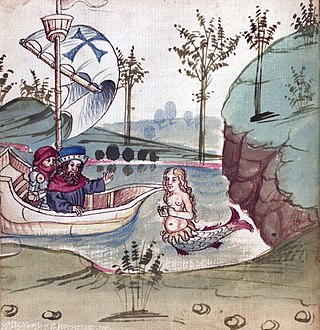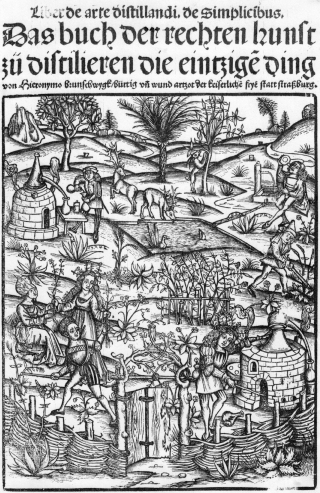
King of the Romans was the title used by the king of Germany following his election by the princes from the reign of Henry II (1002–1024) onward.

The German school of fencing is a system of combat taught in the Holy Roman Empire during the Late Medieval, German Renaissance, and early modern periods. It is described in the contemporary Fechtbücher written at the time. The geographical center of this tradition was in what is now Southern Germany including Augsburg, Frankfurt, and Nuremberg. During the period in which it was taught, it was known as the Kunst des Fechtens, or the "Art of Fighting". The German school of fencing focuses primarily on the use of the two-handed longsword; it also describes the use of many other weapons, including polearms, medieval daggers, messers, and the staff, as well as describing mounted combat and unarmed grappling (ringen).

Ulrich von Hutten was a German knight, scholar, poet and satirist, who later became a follower of Martin Luther and a Protestant reformer.

Patricianship, the quality of belonging to a patriciate, began in the ancient world, where cities such as Ancient Rome had a social class of patrician families, whose members were initially the only people allowed to exercise many political functions. In the rise of European towns in the 12th and 13th centuries, the patriciate, a limited group of families with a special constitutional position, in Henri Pirenne's view, was the motive force. In 19th century Central Europe, the term had become synonymous with the upper Bourgeoisie and cannot be interchanged with the medieval patriciate in Central Europe. In the maritime republics of the Italian Peninsula as well as in German-speaking parts of Europe, the patricians were as a matter of fact the ruling body of the medieval town. Particularly in Italy, they were part of the nobility.
The imperial ban was a form of outlawry in the Holy Roman Empire. At different times, it could be declared by the Holy Roman Emperor, by the Imperial Diet, or by courts like the League of the Holy Court (Vehmgericht) or the Reichskammergericht.

Wolfdietrich is the eponymous protagonist of the Middle High German heroic epic Wolfdietrich. First written down in strophic form in around 1230 by an anonymous author, it survives in four main versions, widely differing in scope and content, and largely independent of each other.

The grand master of the Teutonic Order is the supreme head of the Teutonic Order. It is equivalent to the grand master of other military orders and the superior general in non-military Roman Catholic religious orders. Hochmeister, literally "high master", is only used in reference to the Teutonic Order, as Großmeister is used in German to refer to the leaders of other orders of knighthood.

Sebald Beham (1500–1550) was a German painter and printmaker, mainly known for his very small engravings. Born in Nuremberg, he spent the later part of his career in Frankfurt. He was one of the most important of the "Little Masters", the group of German artists making prints in the generation after Dürer.

Niklaus Manuel Deutsch, of Bern, was a Swiss artist, writer, mercenary and Reformed politician.
Theologia Germanica, also known as Theologia Deutsch or Teutsch, or as Der Franckforter, is a mystical treatise believed to have been written in the later 14th century by an anonymous author. According to the introduction of the Theologia the author was a priest and a member of the Teutonic Order living in Frankfurt, Germany.

The Zimmern Chronicle is a family chronicle describing the lineage and history of the noble family of Zimmern, based in Meßkirch, Germany. It was written in a Swabian variety of Early New High German by Count Froben Christoph of Zimmern (1519–1566). The chronicle is an eminent historical source of information about 16th century nobility in South-West Germany, its culture and its values. It is also an important literary and ethnological source for its many folkloristic texts. The text has survived in two manuscripts, both in possession of the Württembergische Landesbibliothek in Stuttgart.

The German-speaking states of the early modern period were divided politically and religiously. Religious tensions between the states comprising the Holy Roman Empire had existed during the preceding period of the Late Middle Ages —notably erupting in Bohemia with the Hussite Wars (1419–1434). However, the defining religious movement of this period, the Reformation, would result in unprecedented levels of violence and political upheaval for the region.

Solomon and Marcolf is a medieval narrative describing the adventures and conversations of Solomon and Marcolf, or Marolf. The adventures have some connection with those of Ashmedai, while the conversations consist chiefly of riddles similar to those put to Solomon by the Queen of Sheba. The exact extent of its indebtedness to the Haggadah is somewhat doubtful, though it is practically certain that the various versions are derived from an Eastern original.

Agnes von Mansfeld-Eisleben (1551–1637) was Countess of Mansfeld and the daughter of Johann (Hans) Georg I, of Mansfeld Eisleben. She converted Gebhard, Seneschal of Waldburg, the Prince-Elector of Electorate of Cologne and archbishop of the Diocese of Cologne to the Protestant faith, leading to the Cologne War (1583–1588).

The House of Franckenstein is the name of a feudal, Franconian noble family in Germany, descendants from the Dynasts of the Breuberg family; offsprings of the Lords of Lützelbach from Höchst im Odenwald.
Thomas Kantzow was a chronicler in the Duchy of Pomerania. He studied at the universities of Rostock and Wittenberg, and was a secretary of the Pomeranian dukes. His manuscripts, rediscovered in 1729, 1832 and 1973, are written in Low German and Standard German language, and were printed in the 19th and 20th centuries. They contain a Low German and three Standard German chronicles covering the history of Pomerania until 1536.

Heinrich Vogtherr (the Elder) (1490 in Dillingen an der Donau – 1556 in Vienna) was an artist, printer, poet and medical author of the Reformation period.

Hieronymus Brunschwig or Hieronymus Brunschwygk was a German surgeon ("Wundarzt"), alchemist and botanist. He was notable for his methods of treatment of gunshot wounds and for his early work on distillation techniques. His most influential book was the Liber de arte distillandi de simplicibus.

Michiel Hillen van Hoochstraten or Michel Hillenius, was a Flemish printer, publisher, bookseller and bookbinder. His printing press put out publications in a wide range of genres, including imperial ordinances, almanacs, devotional literature, anthologies of customs, textbooks, etc. He also printed humanistic writings by Erasmus, Adrianus Barlandus and Jacobus Latomus as well as the first Dutch-language version of the story of Till Eulenspiegel. His multiple editions of the Bible in Dutch translation were among the first to be published. Michiel Hillen van Hoochstraten is regarded as the most important publisher active in Antwerp in the first half of the sixteenth century.

The Principality of Heitersheim was an imperial estate of the Holy Roman Empire from 1548 until 1806. It was a territory of the Knights Hospitaller consisting of several noncontiguous enclaves in the Breisgau. It was a member of the Upper Rhenish Circle. Before its expansion in 1803, it had an area of about 4 square Reichsmeilen and a population of about 5 000.


















